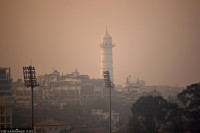Climate & Environment
KMC to launch awareness drive on air pollution
The city office has also started installing portable air quality monitoring devices in various locations.
Post Report
With an aim to make metropolis denizens aware of the consequences of worsening air quality, the Kathmandu Metropolitan City has decided to launch a month-long awareness drive in its jurisdictions.
The move of the Environment Department of the city office comes amid the rise in air pollution in various places across the country, including in the Kathmandu Valley.
“We have decided to launch a month-long awareness drive against the negative impacts of polluted air in our metropolis,” said Sarita Rai, chief of the department. “The campaign, which will start on December 16 [Poush 1], will continue until January 13 (Poush 29).”
With the start of the dry season, Kathmandu’s air quality has been deteriorating of late. According to IQ AirVisual, a Swiss group that collects air-quality data from around the world, Kathmandu ranked 10th in the list of the world’s most-polluted cities with PM2.5 levels reaching 159 micrograms per cubic metre (μg/m3) on Wednesday morning.
PM2.5 refers to particulate matter (solid or liquid droplets) in the air that is less than 2.5 micrometres in diameter. It is among the most dangerous pollutants that can get past the nose and throat to penetrate the lungs and even the bloodstream. PM2.5 particles are small and are also likely to stay suspended in the air for long, increasing the chances of people inhaling them.
As per the Environmental Protection Agency’s air quality index, when air quality reaches 151–200, it is considered unhealthy; everyone may experience problems, with sensitive groups feeling more severe effects.
Rai said that her office will use digital mediums, including social media, to mobilise partner agencies and social organisations to raise public awareness.
“We will also encourage the public to wear face masks while going out of home and not to burn waste, among other things,” said Rai. “As there are several local units in the valley, we hope other locals will follow suit.”
Meanwhile, the department has also started monitoring the city’s air quality independently, with support from the Partnership for Healthy Cities, which has provided portable devices to the city office.
According to Rai, the portable devices have been installed at Lainchaur, Chhetrapati, and KMC’s central office in Kathmandu Plaza. The remaining 15 will also be installed in the coming days.
Nepal’s air quality reaches hazardous levels several times a year, and the capital city often becomes the world’s most polluted metropolis. Major hospitals report a spike in respiratory problems due to the impact of toxic air and dust. Doctors say even if cases of respiratory illnesses surge during winter and as the season changes across the world, in Nepal, people get sick throughout the year due to polluted air.
Doctors say air pollution is known to cause various respiratory illnesses. Poor air quality can cause short- and long-term effects on public health. In the short term, it can lead to pneumonia, bronchitis, conjunctivitis, skin allergy, stroke, and heart problems, and in the long run, it can lead to severe conditions like ulcers, cancer of the lungs and intestine, kidney disease, and heart complications.
People in low- and middle-income countries get disproportionately affected by the polluted air, which accounts for more than 90 percent of deaths, according to the World Health Organisation.
Several studies carried out in the past in Nepal show that toxic air takes a huge toll on public health. Along with respiratory illness, the toxic air has led to severe conditions like ulcers, cancer of the lungs and intestine, kidney disease, heart complications, high blood pressure and stroke, according to experts.
A report, titled “Global burden and strength of evidence for 88 risk factors in 204 countries and 811 subnational locations, 1990–2021: A systematic analysis for the global burden of disease study 2021,” finds that air pollution was the leading contributor to the global disease burden in 2021, making for eight percent of total disability-adjusted life years (DALYs), followed by high blood pressure (7.8 percent). The report was published in The Lancet, a leading international medical journal.
Studies carried out in the past show that polluted air has been shortening people’s lives. Nepali lives are being cut short by around five years, according to a report by the Air Quality Life Index (AQLI), which converts air pollution concentration into an impact on life expectancy. AQLI is a metric produced by the Energy Policy Institute at the University of Chicago.
Toxic air is deadlier than tobacco use and high blood pressure, which reduce life by 2.8 years and 1.7 years, respectively, according to the report.




 9.12°C Kathmandu
9.12°C Kathmandu







%20(1).jpg&w=300&height=200)

